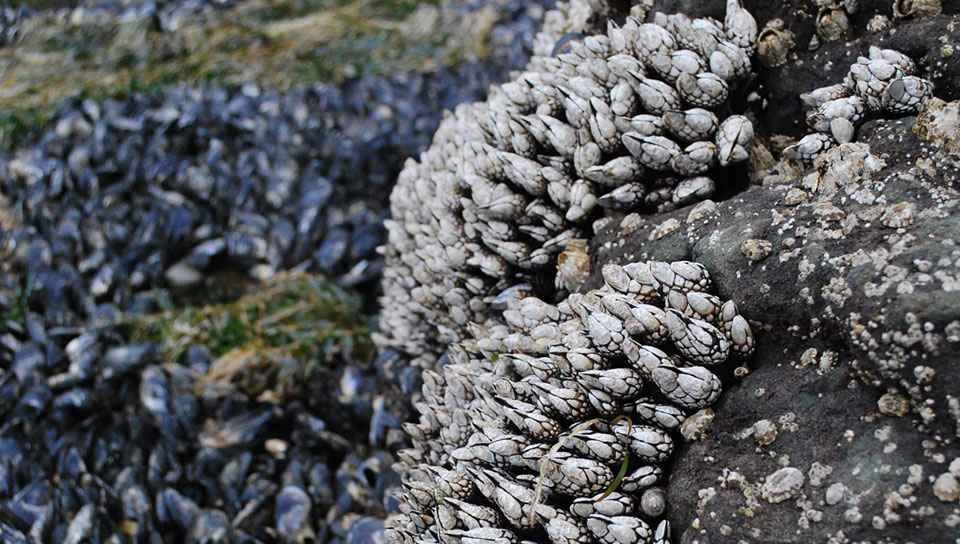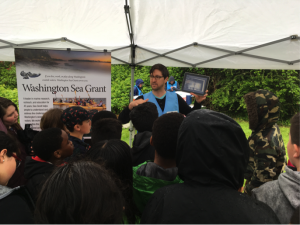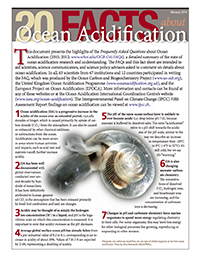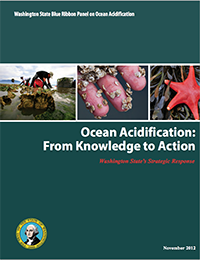The oceans’ absorption of carbon dioxide (CO2) from the atmosphere is causing fundamental changes in seawater chemistry. CO2 reacts with water to form carbonic acid, which makes seawater more acidic. This process, known as ocean acidification (or OA) has a range of potentially harmful consequences for marine life.

Photo: Jeri Cusimano
OA in Washington State
Our state is experiencing ocean acidification sooner and more severely than expected, due to a combination of human and natural causes. Washington Sea Grant (WSG) has been involved in regional efforts to understand and address ocean acidification since corrosive seawater was first suspected as the cause of unexplained die-offs in West Coast oyster hatcheries. WSG continues to actively engage in OA science and policy at state and local levels.

Ocean Acidification in the Pacific Northwest is a fact sheet summarizing our growing understanding of the causes and consequences of OA in the region’s marine waters
Community Engagement
WSG connects you to scientific information and OA experts, through education, presentations, and classroom visits.
-
In September 2016, regional experts and resource managers representing Washington Coastal Treaty Tribes, federal and state agencies, academia, and NGOs convened for a visioning workshop to discuss the designation of Washington’s north outer coast as a sentinel site for ocean acidification. The Olympic Coast Ocean Acidification Sentinel Site (OASeS) workshop was co-sponsored by NOAA’s OA Program, the Office of National Marine Sanctuaries, and Olympic Coast National Marine Sanctuary and facilitated by Washington Sea Grant. A steering committee was put into place in the fall of 2019 to continue these efforts.
-
Members of WSG were involved in the Washington Marine Resources Advisory Council (MRAC) meeting. MRAC creates policy recommendations and engages in outreach addressing OA in Washington State. The most recent meeting was in June of 2021.
- Washington Sea Grant was involved in the fifth NOAA West Coast Acidification Cruise, which set sail in May 2016 to study OA along the entire California Current system, from Baja California to the northern tip of Vancouver Island. This cruise aboard the R/V Brownincluded studies on harmful algal blooms and pteropods. Along the way, the scientists blogged some of their experiences- including explanations of OA chemistry and deployment of instruments. The team also got a chance to share their research throughout the trip. In San Francisco, scientists disembarked for some fun at the Exploratorium, explaining Ocean Acidification to eager crowds, while in Seattle, elementary students got a tour the R/V Brown led by members of the NOAA Corps.
- Meg Chadsey (WSG) worked with Chase Williams (UW) to coordinate and execute outreach efforts on behalf of a Sea Grant funded study investigating the effects of OA on Coho salmon. This study is led by Evan Gallagher of the UW School of Public Health.
 WSG-funded postdoc Chase Williams shows Federal Way School District middle school students a video in which he challenges juvenile Coho salmon with future levels of carbon dioxide to test their ability to avoid predator scent.
WSG-funded postdoc Chase Williams shows Federal Way School District middle school students a video in which he challenges juvenile Coho salmon with future levels of carbon dioxide to test their ability to avoid predator scent. - Washington Sea Grant’s OA team helped facilitate conceptualization of the Olympic Coast National Marine Sanctuary’s Sentinel Site program, which uses near shore monitoring to follow environmental change.
- EarthEcho’s Ocean Acidification expedition, Shell Shocked, brought young students to the Pacific Northwest to learn about the effects of decreased oceanic pH, aided by Meg Chadsey and Washington Sea Grant.
- Meg Chadsey, WSG’s Ocean Acidification specialist and head of the WSG OA team, has been serving as the Sea Grant liaison to NOAA’s Pacific Marine Environmental Laboratory.
We also have several on-going projects in the community:
- WSG partnered with the Puget Sound Restoration Fund, NOAA Pacific Marine Environmental Laboratory, and UW scientists on a proposal funded by the Paul Allen Family Foundation to pilot a novel OA mitigation strategy. The team will evaluate the potential of seaweed aquaculture to ‘scrub’ dissolved CO2 and nutrient pollution from Puget Sound. The project recently tickled some taste buds during an outreach event at the MOHAI Edible Science Fair, where museum goers had the chance to sample some delicious kelp products.
- WSG continues to collaborate with NOAA to produce SOARCE(Sharing Ocean Acidification Resources for Communicators and Educators), a monthly webinar that highlight OA education and communication resources.
- WSG is a founding member of the California Current Acidification Network (C-CAN), formed in 2010. C-CAN helps oversee the dissemination of products and information to the west coast OA community.
Research Projects
WSG supports a strong OA research program. Since 2010, we’ve invested almost $1.5 million to improve our understanding of how Pacific Northwest marine species will be affected by OA, and ways to mitigate these impacts.
- Quinault Reservation hypoxia monitoring
- OA effects on Puget Sound calcifers
- OA impacts on salmon olfaction & magnetoreception
- Eelgrass and oysters: Potential partners in a changing ocean
- OA effects on salmon and sablefish
- OA effects on mussel attachment strength
- Breeding OA-resistant oysters
- OA effects on WA crustacean zooplankton
- OA exposure effects on Pacific oysters
- OA effects on declining Puget Sound shellfish
In the News
Due to a combination of human activities and natural factors, acidification in the Pacific Northwest is particularly severe. The region has also become a hotspot for both OA science and policy. Some recent developments:
- Washington Legislature Provides Funds for Kelp and Eelgrass Protection The Chronicle, April 11, 2022
- Salish Sea providing a ‘window’ into the future of ocean acidification K5 News, February 24, 2022
- Ocean acidification impacts oysters’ memory of environmental stress
UW News, March 12, 2020 -
Washington researchers tackle ocean acidification with new seaweed crops
KNKX, February 6, 2020 - Ocean acidification Is dissolving shells of young Dungeness Crab
OPB, January 30, 2020 -
Climate change was killing Northwest oysters. Growers and scientists fought back
December 13, 2019 -
Similar coasts, similar stories: How Washington’s ocean acidification research and action is drawing global interest
WA Governor’s Office, November 26, 2019

